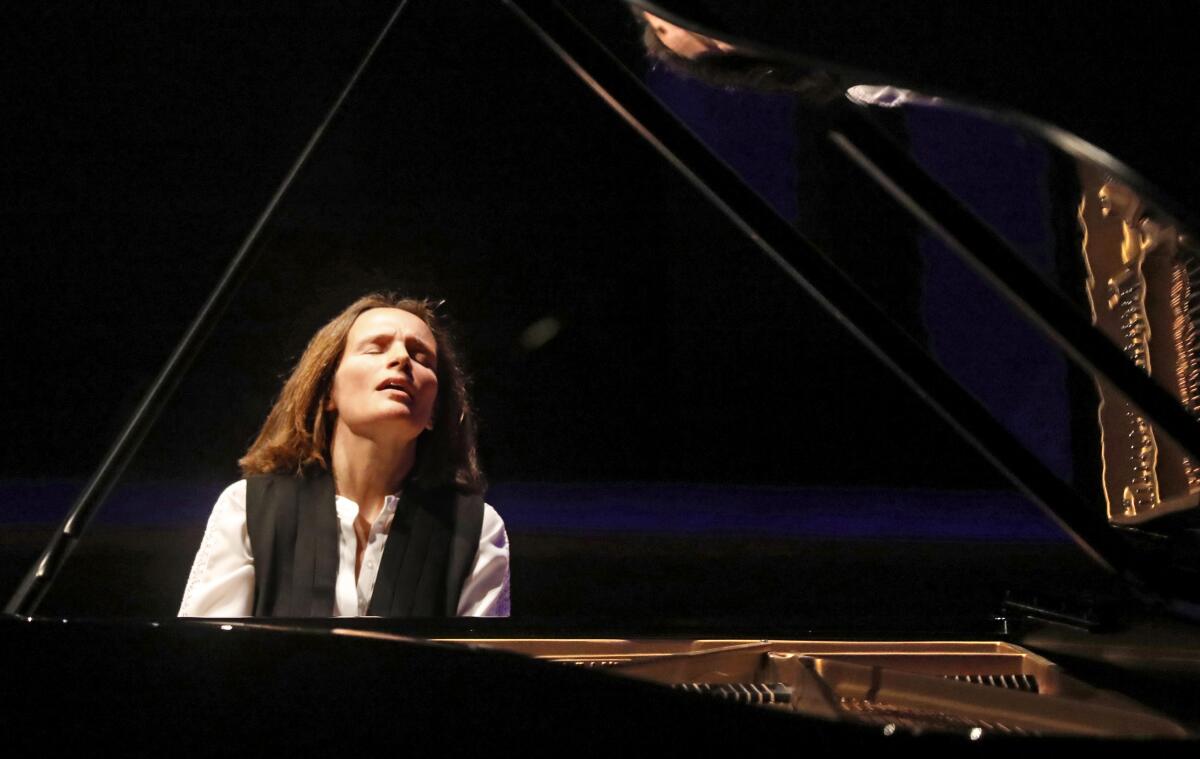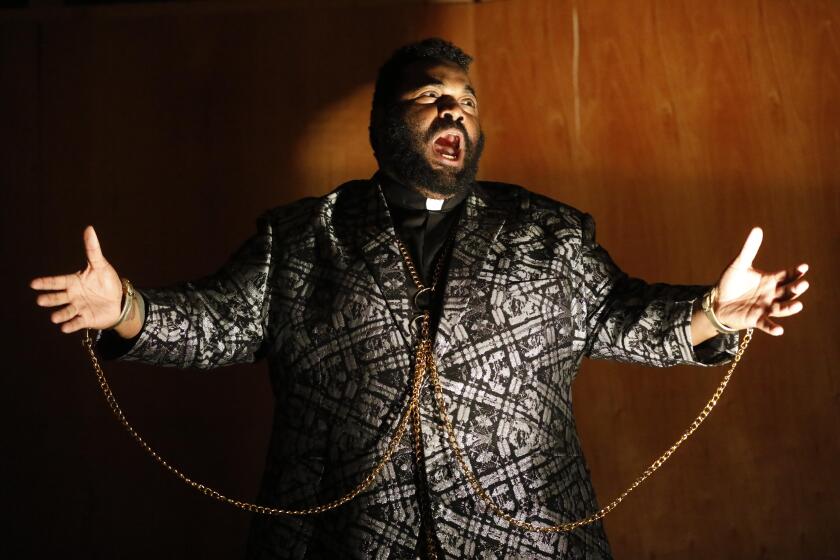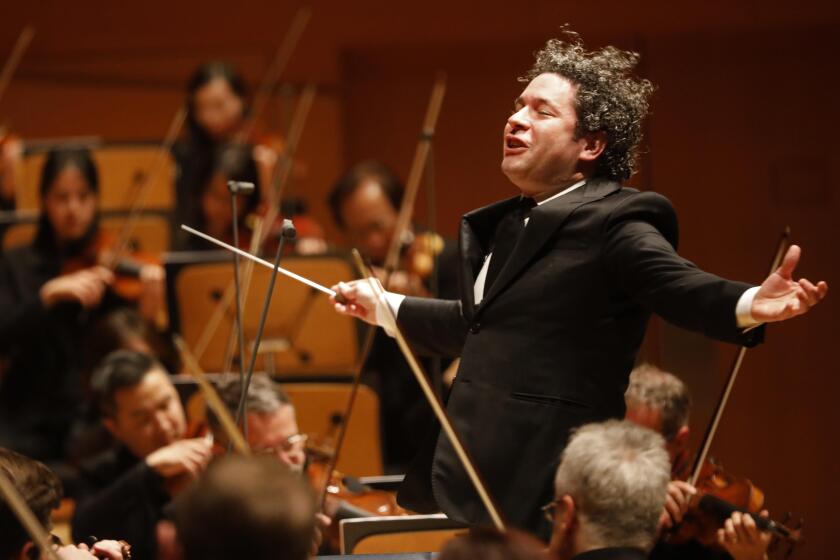Commentary: Yuja Wang and Hélène Grimaud, two case studies in stardom

- Share via
What’s up with Yuja?
I’ve heard that question quite a bit about Yuja Wang’s recital last week at Walt Disney Concert Hall. She seemed out of sorts. She announced that she would play her mixed program of two dozen pieces that ranged in length from two minutes to 11 not in the listed order but how she felt at the moment, an intriguing idea but one that confused many.
She played brilliantly. She dressed in her famous, fabulous way. She tottered, as ever, on Everest-high heels.
But given her curt manner and how long she took to return for encores, the presumption was that she had to be talked into doing so. She further managed to antagonize this newspaper by insisting on photo approval, which, of course, is an unacceptable challenge to the freedom of the press.
With a creative team of Native, Chinese and African American artists, ‘Sweet Land’ revisits the founding of America through a different lens.
She repeated the recital program two nights later at the Renée and Henry Segerstrom Concert Hall in Orange County. She ended standing by the piano “with what appeared to me a very displeased look,” Timothy Mangan wrote for Voice of OC, “and left. No encore for you!”
The next night Wang performed the same program in Vancouver wearing dark glasses, enraging some members of the audience on social media. The Chinese pianist later explained that she had been treated very badly that day by Canadian immigration officials at the airport. Her eyes were red from crying all afternoon, and she didn’t feel it would be right to play like that, but she also didn’t want to let her fans down.
Who says that virtuosos operating in a high-stress arena have to be touchy-feely? Some are and some aren’t. People are complicated, and exceptional artists are exceptionally complicated. No one, as far as I’ve heard, had anything but amazement to report about Wang’s actual playing.
Wednesday night, barely a week after Wang’s appearance at Disney, French pianist Hélène Grimaud gave a deeply thoughtful recital in the hall. She played a first half that was not unlike Wang’s in being a mix of short pieces, and she played it with a serene beauty. She ended her recital with an enraptured account of Schumann’s “Kreisleriana,” which Wang had played with sparkling flamboyance in Santa Barbara four years ago.
Each pianist was self-possessed in the extreme. Wang attacks the piano. Grimaud plays as if at one with her instrument. Wang braves her audience. Grimaud communes.
The Los Angeles Philharmonic, which presented both recitals and has long had a close relationship with both pianists, owns two superb Steinways. Wang played one made in Hamburg, Germany, that was restored last summer, and her gleaming, percussive tone was so vivid it could make a listener’s flesh tingle. Grimaud chose the more modern American Steinway, which has been otherwise neglected this season, and produced a glowing sound that seemed to suffuse every inch of the hall with its transformative warmth.
Better than Leonard Bernstein? You bet. Gustavo Dudamel and the L.A. Phil deliver a vibrant, rapturous start to an unlikely symphony cycle.
Grimaud and Wang are obviously very different and very special pianists. But maybe they are not as different as all that. Grimaud’s recital represented not so much a correction or alternative to Wang’s but an eye-opener.
A generation older than Wang, Grimaud, 50, in fact, helped to pave the way. She made a splash in her 20s for being beautiful and headstrong. She caused controversy by wearing what some thought was inappropriate concert dress. She was called too impulsive. She played brawny repertory, such as Brahms’ First Piano Concerto, thought ill-suited for an elfin young woman. To top it off, she kept wolves.
But put her face on a CD cover, and it would sell.
What was, or at least should have also been, clear from the start is that Grimaud is an exceptional pianist with an original and probing mind who takes no note for granted. As she has grown, she has only gotten deeper.
The first half of her recital contained 13 very short pieces that she dubbed as relating to the idea of the fleeting sensation of memory. Her playing was liquid, grounded and airy at the same time. A very familiar piece like Debussy’s “Clair de Lune,” a Chopin waltz or a Satie Gnossiénne took on new luster. She showed the changing moods of “Kreisleriana” to be profoundly revealing studies of a psyche in flux. She physically dominated the keyboard on three Rachmaninoff études tableaux encores. But, in the end, she produced a profound sense of mystery.
Wang did something very similar by mixing together a group of late Brahms intermezzi (a Grimaud specialty) with Chopin mazurkas. She has described her program — which also included two Scriabin sonatas (the mystical Fourth and the ecstatic Fifth) and Berg’s early expressionistic Piano Sonata — as part of her own inner searching, a “tapping into the soul.” She came impressively close to that in a clearly articulated performance of Bach’s C-Minor Toccata, BWV 911.
The ordering of the program on the page didn’t make any particular sense, and her spontaneous changes probably didn’t make much difference. This was not a journey but an exploratory ramble. That there was much coughing in the audience (a problem in Grimaud’s concert as well, but one the pianist ignored) while Wang felt she was exposing herself, which might explain the angry ferociousness with which she unleashed her monster technique on Prokofiev’s Toccata as one of her encores. It was a knockout.
Wang is clearly restless. She has been changing her management at a great clip. She has maybe gotten carried away with her image.
But if her recent demeanor suggests a high degree of sensitivity, she is an artist who is experimenting and questioning. And aren’t these exactly the qualities a 33-year-old pianist with immense promise needs to grow?
That’s a rhetorical question. We’ve already know the answer from Grimaud.
More to Read
The biggest entertainment stories
Get our big stories about Hollywood, film, television, music, arts, culture and more right in your inbox as soon as they publish.
You may occasionally receive promotional content from the Los Angeles Times.













